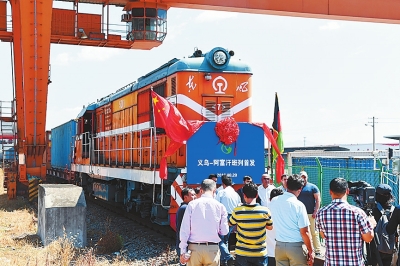Scholars: Small cities must capitalize on unique features

On Aug. 28, 2016, the first freight train from Yiwu to Afghanistan departs from Yiwu, the biggest commodity wholesale market and an exemplary model for the development of small cities in China.
The development of small and medium-sized cities in China was the theme of a forum recently held in Hubei Province by the central committee of the China Zhi Gong Party, one of China’s eight non-Communist parties.
Cities in China with an urban population of less than one million are classified as small and medium-sized cities. An important part of China’s urban-rural structure and economy as the nation enters the “new normal,” small cities are playing an increasingly important role in China’s economic development and urbanization.
The shortage of resources and talent to drive innovation has long been an obstacle for technological development in small cities.
Small cities usually have a weak foundation for science and technology, said Hu Xiaoping, a research fellow from the Institute of International Economy at Zhejiang University. It is relatively more practical to encourage innovation inside industries and enterprises rather than research institutions and universities, he said.
Zhang Jun, a research fellow from the Rural Development Institute at the Chinese Academy of Social Sciences, echoed with Hu, adding that the enterprises should be the major forces for innovation through cooperation with research facilities, and high-tech zones should be the engines of innovation for industrial development.
Compared with mega cities—which have concentrated resources, large economies and a mature industrial structure—the economic growth of small cities has more tension with the idea of green and low-carbon development.
The government should implement the policies concerning the industry location in urban planning and improve the living environment, said Gao Jixi, director-general of the Nanjing Institute of Environmental Sciences under the nation’s Ministry of Environmental Protection. Also a sound regulating mechanism on the property rights and use of natural resources assets should be established, he said.
Li Yunyan, a professor of environmental economics from Beijing University of Technology, stressed public participation in coping with ecological crises, adding that the government should be more transparent in disclosing information about environmental protection.
The “smart city” concept that emphasizes the integration of information technologies and the Internet of Things into city planning, is creating an opportunity for small cities to resolve the existing problems in urban safety regulation regarding water service, gases, airports and transportation, said Yi Zhi, a professor from the School of Finance at Zhejiang University of Finance and Economics.
The homogenization of China’s city development ever since the nation’s reform and opening-up has been a notable phenomenon.
Zhou Weizhong, a professor from the Business School at the Central University of Finance and Economics, said small cities should explore the local resources and develop regional brands with local characteristics, adding that they should be able to tell the stories about the enterprises, the cities and the brands.
Introducing the concept of cultural innovation into small city development will contribute to the construction of an urban economy while simultaneously protecting and preserving cultural heritage and historical characteristics, said Wang Yu, a professor from the School of History and Culture Industry at the University of Jinan.
